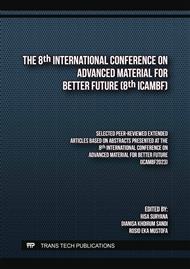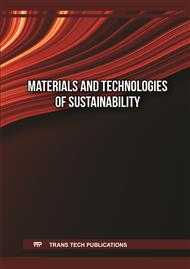[1]
J. Gong, K. Sumathy, Q. Qiao, Z. Zhou, Review on dye-sensitized solar cells (DSSCs): Advanced techniques and research trends, Renew. Sustain. Energy Rev. 68 (2017) 234–246.
DOI: 10.1016/j.rser.2016.09.097
Google Scholar
[2]
S.N. Karthick, K. V. Hemalatha, S.K. Balasingam, F. Manik Clinton, S. Akshaya, H.J. Kim, Dye-sensitized solar cells: History, components, configuration, and working principle, Interfacial Eng. Funct. Mater. Dye. Sol. Cells. (2019) 1–16. https://doi.org/10.1002/ 9781119557401.ch1.
DOI: 10.1002/9781119557401.ch1
Google Scholar
[3]
P.D. Nixon, R. Baby, N.M. Kumar, N. Ananthi, Natural Dyes from Ornamental Plants as Sensitizers for Dye-Sensitized Solar Cells (DSSCs): A Review on the Structure-Activity Relationships (SARs) between Power Conversion Efficiencies and Chemical Constituents, Russ. J. Appl. Chem. 94 (2021) 1561–1576.
DOI: 10.1134/S1070427221120016
Google Scholar
[4]
N.Y. Amogne, D.W. Ayele, Y.A. Tsigie, Recent advances in anthocyanin dyes extracted from plants for dye sensitized solar cell, Mater. Renew. Sustain. Energy. 9 (2020) 1–16.
DOI: 10.1007/s40243-020-00183-5
Google Scholar
[5]
S. Ilic, V. Paunovic, Characteristics of curcumin dye used as a sensitizer in dye-sensitized solar cells, Facta Univ. - Ser. Electron. Energ. 32 (2019) 91–104. https://doi.org/10.2298/ fuee1901091i.
DOI: 10.2298/fuee1901091i
Google Scholar
[6]
D.D. Pratiwi, F. Nurosyid, A. Supriyanto, R. Suryana, Optical properties of natural dyes on the dye-sensitized solar cells (DSSC) performance, J. Phys. Conf. Ser. 776 (2016).
DOI: 10.1088/1742-6596/776/1/012007
Google Scholar
[7]
A.H. Ahliha, F. Nurosyid, A. Supriyanto, T. Kusumaningsih, The chemical bonds effect of anthocyanin and chlorophyll dyes on TiO2 for dye-sensitized solar cell (DSSC), J. Phys. Conf. Ser. 909 (2017).
DOI: 10.1088/1742-6596/909/1/012013
Google Scholar
[8]
I. Nyoman Setiawan, I.A. Dwi Giriantari, W.G. Ariastina, I.B. Alit Swamardika, Natural Dyes Extracted from Bioactive Components of Fruit Waste for Dye-Sensitized Solar Cell, Int. J. Eng. Res. Technol. 13 (2020) 2498–2504.
DOI: 10.37624/ijert/13.9.2020.2498-2504
Google Scholar
[9]
N. Burhan, H.P. Uranus, Performance Degradation Model of Dye-Sensitized Solar Cell (DSSC) Using Dye Extracted from Red Dragon Fruit's Flesh, J. Phys. Conf. Ser. 1552 (2020).
DOI: 10.1088/1742-6596/1552/1/012001
Google Scholar
[10]
H.J. Kim, D.J. Kim, S.N. Karthick, K. V. Hemalatha, C. Justin Raj, S. Ok, Y. Choe, Curcumin dye extracted from Curcuma longa L. used as sensitizers for efficient dye-sensitized solar cells, Int. J. Electrochem. Sci. 8 (2013) 8320–8328.
DOI: 10.1016/s1452-3981(23)12891-4
Google Scholar
[11]
N. Sofyan, F.W. Situmorang, A. Ridhova, A.H. Yuwono, A. Udhiarto, Visible light absorption and photosensitizing characteristics of natural yellow 3 extracted from Curcuma Longa L. for Dye-Sensitized solar cell, IOP Conf. Ser. Earth Environ. Sci. 105 (2018).
DOI: 10.1088/1755-1315/105/1/012073
Google Scholar
[12]
D. Sinha, D. De, A. Ayaz, Performance and stability analysis of curcumin dye as a photo sensitizer used in nanostructured ZnO based DSSC, Spectrochim. Acta - Part A Mol. Biomol. Spectrosc. 193 (2018) 467–474.
DOI: 10.1016/j.saa.2017.12.058
Google Scholar
[13]
T.A. Ruhane, M.T. Islam, M.S. Rahaman, M.M.H. Bhuiyan, J.M.M. Islam, M.K. Newaz, K.A. Khan, M.A. Khan, Photo current enhancement of natural dye sensitized solar cell by optimizing dye extraction and its loading period, Optik (Stuttg). 149 (2017) 174–183.
DOI: 10.1016/j.ijleo.2017.09.024
Google Scholar
[14]
T.A. Ruhane, M.T. Islam, M.S. Rahaman, M.M.H. Bhuiyan, J.M.M. Islam, T.I. Bhuiyan, K.A. Khan, M.A. Khan, Impact of photo electrode thickness and annealing temperature on natural dye sensitized solar cell, Sustain. Energy Technol. Assessments. 20 (2017) 72–77.
DOI: 10.1016/j.seta.2017.01.012
Google Scholar
[15]
P. Gu, D. Yang, X. Zhu, H. Sun, J. Li, Performance of dye-sensitized solar cells based on natural dyes, Opt. Quantum Electron. 50 (2018) 1–13.
DOI: 10.1007/s11082-018-1485-1
Google Scholar
[16]
A.H. Ahliha, F. Nurosyid, A. Supriyanto, T. Kusumaningsih, Optical properties of anthocyanin dyes on TiO2 as photosensitizers for application of dye-sensitized solar cell (DSSC), IOP Conf. Ser. Mater. Sci. Eng. 333 (2018).
DOI: 10.1088/1757-899X/333/1/012018
Google Scholar
[17]
N. Puspitasari, G. Prajitno, F.S. Mas Fakarani, G. Yudoyono, Darminto, Anthocyanin Development from Fruit Waste for Dye Sensitized Solar Cell Applications, J. Phys. Conf. Ser. 1951 (2021).
DOI: 10.1088/1742-6596/1951/1/012048
Google Scholar
[18]
N.E.H. Diyanahesa, A. Supriyanto, A.H. Ramelan, Improvement of efficiency of dye-sensitized solar cells (DSSC) transparent by optimizing of anthocyanin dyes hybrid dyenamo yellow (DN-F01), AIP Conf. Proc. 2217 (2020).
DOI: 10.1063/5.0000868
Google Scholar
[19]
R. Anoua, H. Lifi, S. Touhtouh, M. El Jouad, A. Hajjaji, M. Bakasse, P. Płociennik, A. Zawadzka, Optical and morphological properties of Curcuma longa dye for dye-sensitized solar cells, Environ. Sci. Pollut. Res. 28 (2021) 57860–57871.
DOI: 10.1007/s11356-021-14551-9
Google Scholar
[20]
K. Portillo-Cortez, A. Martínez, A. Dutt, G. Santana, N719 Derivatives for Application in a Dye-Sensitized Solar Cell (DSSC): A Theoretical Study, J. Phys. Chem. A. 123 (2019) 10930–10939.
DOI: 10.1021/acs.jpca.9b09024
Google Scholar
[21]
Safie Nur Ezyanie, Ludin Norasikin Ahmad, Su'ait Mohd Sukor, Hamid Norul Hisham, Sepeai Suhaila, Ibrahim Mohd Adib, Teridi Mohd Asri Mat, Preliminary Study Of Natural Pigments Photochemical Properties of Curcuma longa L. and Lawsonia inermis L. AS TiO2 Photoelectrode Sensitizer, Malaysian J. Anal. Sci. 19 (2015) 1243–1249.
DOI: 10.1002/9783527690312.ch16
Google Scholar
[22]
K. Ahmed Ismail, A. El Askary, M.O. Farea, N.S. Awwad, H.A. Ibrahium, M. Eid Moustapha, A.A. Menazea, Perspectives on composite films of chitosan-based natural products (Ginger, Curcumin, and Cinnamon) as biomaterials for wound dressing, Arab. J. Chem. 15 (2022) 103716.
DOI: 10.1016/j.arabjc.2022.103716
Google Scholar
[23]
T. Azizi, Z. Kaddachi, M. Ben Karoui, A.E. Touihri, R. Gharbi, Electrical Characterization and Efficiency Enhancement of Dye Sensitized Solar Cell Using Natural Sensitizer and TiO2Nanoparticles Deposited by Electrophoretic Technique, IEEE J. Photovoltaics. 11 (2021) 1004–1013.
DOI: 10.1109/JPHOTOV.2021.3075322
Google Scholar
[24]
S. Wanwong, W. Sangkhun, J. Wootthikanokkhan, The effect of co-sensitization methods between N719 and boron dipyrromethene triads on dye-sensitized solar cell performance, RSC Adv. 8 (2018) 9202–9210.
DOI: 10.1039/c8ra00862k
Google Scholar
[25]
W.A. Dhafina, M.Z. Daud, H. Salleh, The sensitization effect of anthocyanin and chlorophyll dyes on optical and photovoltaic properties of zinc oxide based dye-sensitized solar cells, Optik (Stuttg). 207 (2020).
DOI: 10.1016/j.ijleo.2019.163808
Google Scholar
[26]
E.C. Prima, H.S. Nugroho, Nugraha, G. Refantero, C. Panatarani, B. Yuliarto, Performance of the dye-sensitized quasi-solid state solar cell with combined anthocyanin-ruthenium photosensitizer, RSC Adv. 10 (2020) 36873–36886.
DOI: 10.1039/d0ra06550a
Google Scholar
[27]
A. Omar, M.S. Fakir, K.S. Hamdan, N.H. Rased, N.A. Rahim, Photovoltaic performances and lifetime analysis of TiO2/rGO DSSCs sensitized with Roselle and N719 dyes, IOP Conf. Ser. Mater. Sci. Eng. 1127 (2021) 012041.
DOI: 10.1088/1757-899x/1127/1/012041
Google Scholar
[28]
N. Kato, K. Higuchi, H. Tanaka, J. Nakajima, T. Sano, T. Toyoda, Improvement in long-term stability of dye-sensitized solar cell for outdoor use, Sol. Energy Mater. Sol. Cells. 95 (2011) 301–305.
DOI: 10.1016/j.solmat.2010.04.019
Google Scholar
[29]
R. Jiang, A. Anderson, P.R.F. Barnes, L. Xiaoe, C. Law, B.C. O'Regan, 2000 Hours Photostability Testing of Dye Sensitised Solar Cells Using a Cobalt Bipyridine Electrolyte, J. Mater. Chem. A. 2 (2014) 4751–4757.
DOI: 10.1039/c4ta00402g
Google Scholar
[30]
M.I. Bachtiar, M.N.P. Agustina, L.W. Hariyani, F. Nurosyid, Effect of dye variation on DSSC efficiency, J. Phys. Conf. Ser. 1153 (2019).
DOI: 10.1088/1742-6596/1153/1/012097
Google Scholar
[31]
S. Rahman, A. Haleem, M. Siddiq, M.K. Hussain, S. Qamar, S. Hameed, M. Waris, Research on dye sensitized solar cells: recent advancement toward the various constituents of dye sensitized solar cells for efficiency enhancement and future prospects, RSC Adv. 13 (2023) 19508–19529.
DOI: 10.1039/d3ra00903c
Google Scholar
[32]
F. Kabir, M.M.H. Bhuiyan, M.R. Hossain, H. Bashar, M.S. Rahaman, M.S. Manir, S.M. Ullah, S.S. Uddin, M.Z.I. Mollah, R.A. Khan, S. Huque, M.A. Khan, Improvement of efficiency of Dye Sensitized Solar Cells by optimizing the combination ratio of Natural Red and Yellow dyes, Optik (Stuttg). 179 (2019) 252–258.
DOI: 10.1016/j.ijleo.2018.10.150
Google Scholar
[33]
M. Khan, M.A. Iqbal, M. Malik, S.U.M. Hashmi, S. Bakhsh, M. Sohail, M.T. Qamar, M. Al-Bahrani, R.Y. Capangpangan, A.C. Alguno, J.R. Choi, Improving the efficiency of dye-sensitized solar cells based on rare-earth metal modified bismuth ferrites, Sci. Rep. 13 (2023) 1–14.
DOI: 10.1038/s41598-023-30000-8
Google Scholar
[34]
A.R. Woldu, D.W. Ayele, N.G. Habtu, Y.A. Tsigie, Anthocyanin components for dye-sensitized solar cells extracted from Teclea Shimperi fruit as light-harvesting materials, Mater. Sci. Energy Technol. 3 (2020) 889–895.
DOI: 10.1016/j.mset.2020.11.001
Google Scholar
[35]
S. Ananthakumar, D. Balaji, J. Ram Kumar, S. Moorthy Babu, Role of co-sensitization in dye-sensitized and quantum dot-sensitized solar cells, Springer International Publishing, 2019.
DOI: 10.1007/s42452-018-0054-3
Google Scholar



